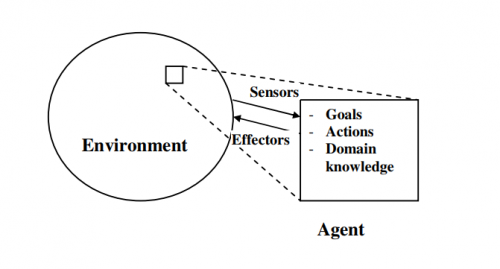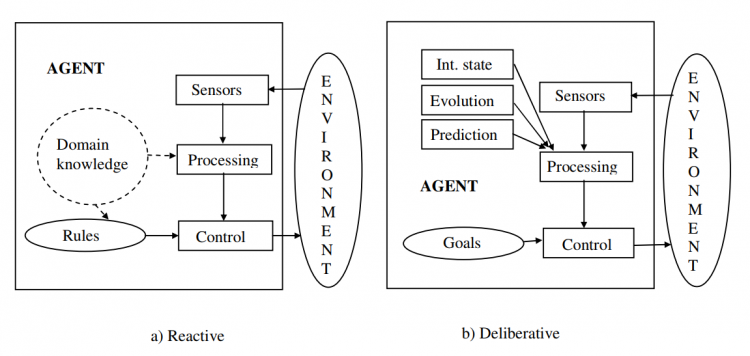Agents
Agents definition
First of all, when talking about agents and multi-agent systems we should try to define what an agent is, however there is no one strict definition, a variety of different definitions exists. Some of them are quite simple, others are much more demanding. All strongly influenced by their background. A different definition will be used in area of artificial intelligence than in area of software engineering. A simple but clear and well understandable definition comes from S. Russel and P. Norvig:
“An agent is anything that can be viewed as perceiving its environment through sensors and acting upon that environment through effectors”.
Another, more precise definition that extends the one above is from P. Maess:
“Autonomous agents are computational systems that inhabit some complex dynamic environment, sense and act autonomously in this environment, and by doing so realize a set of goals or tasks for which they are deigned”
The second definition specifies the kind of agents we are interested in (it talks about computational agents which belongs to the area of engineering and has nothing to with natural agents from the field of biology such as human). It also says the agent are autonomous, which means they have a control over their actions and operate without direct interventions of other entities. Last difference from previous definition is that they are acting in order to achieve some specific goals.
An example of an agent according to a previous description is a thermostat. A simple autonomous device which is supposed to maintain temperature in a room. Maintaining the temperature is its goal. It contains a sensor to check what an actual temperature in the room is, a memory to remember what the desired temperature is and the values from the sensor and a decision-making function which compares the measured temperature with the desired one (making this decision is an action) and based on the result (using domain knowledge what to do when actual temperature is lower/higher that desired temperature) commands to turn the heating or the air conditioner on/off (commanding the heating is an effector).
Very similar specific definition is almost twenty years old and comes from G. Weiss (1999)
“An agent is a computer system that is situated in some environment, and that is capable of autonomous action in this environment in order to meet its design objectives”
From those three definitions we can see that an agent can be almost anything but in many cases, it is more specified and only a certain kind of agents is acceptable for a certain problem.
Agents characteristics
Communication and environment perception are two basic characteristics of agents. They might look very similar but in some situations it is better to distinguish them. Agents use their senses to perform perception and thank to it they obtain unstructured information from their environment whereas during communication, two or more agents are sending and receiving structured information to and from each other. This ability is crucial for a group of agents to work as a system. It would not be possible without communication. Communication is also necessary prerequisite for more advanced interactive abilities of agents such as cooperation, coordination or competition, also called social abilities.
Next one of basic characteristics of agents is reactiveness. Thanks to previous abilities, agents can perceive or receive an information but it’s the same important that they can react to it. They can perform different actions based on a decision they made. The decision-making process can be simple but also very complicated and sophisticated, depend on specific agents. After deciding what to do, agents act towards the environment or other agents.
Another characteristic is an autonomy, which means each agent can decide solely, acts without external intervention and has control over its actions. When they are supposed to act autonomously, they need to have some goals that they try to achieve to be able to make decisions. We say, they are goal-oriented.
Last characteristic mentioned here is initiative. Agents do not only act when they are asked to but also autonomously on their own initiative to fulfil their objectives.
Another author names similar list of agent’s properties, claiming these are the most frequently mentioned ones:
| Property | Meaning |
|---|---|
| Reactive | Responds in a timely fashion to changes in the environment |
| Autonomous | Exercises control over its own actions |
| Goal-oriented | Does not simply act in response to the environment |
| Temporally continuous | Is a continuously running process |
| Communicative | Communicates with other agents |
| Learning | Changes its behavior based on its previous experience |
| Mobile | Able to transport itself from one machine to another (this is associated manly with software agents) |
| Flexible | Actions are not scripted |
Note: Some of the properties mentioned above applies only for some kinds of agents, not all of them.
Categorization of agents
As well as for the definition even for categorization of agents there are many authors and many different taxonomies. According to the first definition, agent are entities that senses their environment and acting over it. They can be physical, virtual or a combination of both. Base on their physical substance we can divide artificial and natural agents.
Artificial agents: there are different kind of artificial agents, we can divide them in a following way:
• Physical agents are tangible entities existing in a real world. As an example, you can imagine some sensors or any electronic devices. However, to their proper function they are nowadays often combined with a virtual agent – a software.
• Virtual agents also called software agents are pieces of code that performs a certain function. An example of a virtual agent can be a computer virus.
Natural agents: humans, animals, bacteria or viruses can be considered as natural agents. Most often we can come across this term in biology.
Many authors use distribution of agents based on their way of reasoning for deliberative, reactive and hybrid agents.
Reactive agents
Also called behaviour-based agents or purely reactive agents. They do not use artificial intelligence for reasoning about their environment. In contrast with deliberative agents, reactive ones do not create any models to plan their next actions but simply react to a current perception. They are far simpler than deliberative agent but that does not make them less important. Thanks to their simplicity, its easier, faster and cheaper to develop them and to find and fix any problems if occurs.
Let’s talk a bit about reactive agents’ architecture. They consist of behaviours – decentralized competence modules organized into a global structure. We often do not distinguish functional units such as sensors or decision-making units but the input from sensor it straight connected to a behaviour that produces an output and together it creates one module.
One of the most used architectures in reactive agents is subsumption architecture by Brooks which is based on using several layers, each describing some action and a condition leading to this action. This architecture has two key assumption:
• Situatedness and embodiment: It is important for agents to be physically present in the environment and get all the information from sensing the environment or receiving from other agents
• Intelligence and emergence: There is no intelligence of agents themselves, it all comes from their interaction. That is why reactive agents mostly exist as a system, not solely.
The agents sense, check the condition and perform the action. Each layer has its sensors and effectors and looks following: If condition then action. The lower layer, the higher priority. Let’s look at how Brooks described the layers:
0. Avoid objects
1. Wander
2. Explore
3. Build maps
4. Monitor changes
5. Identify objects
6. Plan changes to the world
7. Reason about behaviour of objects
The lower layer (layer 0.) has the highest priority, which means, the most important thing for the agent is to avoid any obstacles. When there is no obstacle the agent can wander around the world without crashing any objects and so on. The first matching rule applies.
Another architectonic approach is agent network architecture by Maes. The behaviours are not organized in layer but in networks of interconnected modules. Two types of modules are distinguished – action modules (to perform certain action) and belief modules (to hold agent’s attitudes). The functions are driven by signals from sensors and goals represented in belief modules. Similarities with neural networks can be found in this approach.
To sum it up, reactive agents are quite simple, have no artificial intelligence and perform real reasoning, only react to the perceptions, create no models of the environment in their memory, needs to be present in the environment, their intelligence comes from their mutual interaction.

